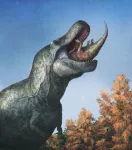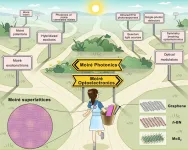(Press-News.org) BOSTON – Aging, or senescent cells, which stop dividing but don’t die, can accumulate in the body over the years and fuel chronic inflammation that contributes to conditions such as cancer and degenerative disorders.
In mice, eliminating senescent cells from aging tissues can restore tissue balance and lead to an increased healthy lifespan. Now a team led by investigators at Massachusetts General Hospital (MGH), a founding member of Mass General Brigham (MGB), has found that the immune response to a virus that is ubiquitously present in human tissues can detect and eliminate senescent cells in the skin.
For the study, which is published in Cell, the scientists analyzed young and old human skin samples to learn more about the clearance of senescent cells in human tissue.
The researchers found more senescent cells in the old skin compared with young skin samples. However, in the samples from old individuals, the number of senescent cells did not increase as individuals got progressively older, suggesting that some type of mechanism kicks in to keep them in check.
Experiments suggested that once a person becomes elderly, certain immune cells called killer CD4+ T cells are responsible for keeping senescent cells from increasing. Indeed, higher numbers of killer CD4+ T cells in tissue samples were associated with reduced numbers of senescent cells in old skin.
When they assessed how killer CD4+ T cells keep senescent cells in check, the researchers found that aging skin cells express a protein, or antigen, produced by human cytomegalovirus, a pervasive herpesvirus that establishes lifelong latent infection in most humans without any symptoms. By expressing this protein, senescent cells become targets for attack by killer CD4+ T cells.
“Our study has revealed that immune responses to human cytomegalovirus contribute to maintaining the balance of aging organs,” says senior author Shawn Demehri, MD, PhD, director of the High Risk Skin Cancer Clinic at MGH and an associate professor of Dermatology at Harvard Medical School. “Most of us are infected with human cytomegalovirus, and our immune system has evolved to eliminate cells, including senescent cells, that upregulate the expression of cytomegalovirus antigens.”
These findings, which highlight a beneficial function of viruses living in our body, could have a variety of clinical applications. “Our research enables a new therapeutic approach to eliminate aging cells by boosting the anti-viral immune response,” says Demehri. “We are interested in utilizing the immune response to cytomegalovirus as a therapy to eliminate senescent cells in diseases like cancer, fibrosis and degenerative diseases.”
Demehri notes that the work may also lead to advances in cosmetic dermatology, for example in the development of new treatments to make skin look younger.
Co-authors include Tatsuya Hasegawa, Tomonori Oka, Heehwa G. Son, Valeria S. Oliver-García, Marjan Azin, Thomas M. Eisenhaure, David J. Lieb, and Nir Hacohen.
This study was supported by the Burroughs Wellcome Fund and Shiseido Co. Ltd.
About the Massachusetts General Hospital
Massachusetts General Hospital, founded in 1811, is the original and largest teaching hospital of Harvard Medical School. The Mass General Research Institute conducts the largest hospital-based research program in the nation, with annual research operations of more than $1 billion and comprises more than 9,500 researchers working across more than 30 institutes, centers and departments. In July 2022, Mass General was named #8 in the U.S. News & World Report list of "America’s Best Hospitals." MGH is a founding member of the Mass General Brigham healthcare system.
END
Boosting the body’s anti-viral immune response may eliminate aging cells
Strategy could restore tissue balance and target cells that contribute to aging-related diseases
2023-03-30
ELSE PRESS RELEASES FROM THIS DATE:
Revealing the pattern between frontal polymerization and natural convection
2023-03-30
A self-propagating chemical reaction can transform a liquid monomer into a solid polymer and the interaction between the propagating front and the reaction’s natural convection leads to patterns in the resulting solid polymeric material. New University of Illinois Urbana-Champaign work has shown how the coupling between natural convection and frontal polymerization leads to those observed patterns.
This research was led by a unique team of researchers- Materials Science and Engineering professor Nancy Sottos, Aerospace Engineering professor Philippe Geubelle, and Mechanical Science and Engineering ...
New mechanisms and therapeutic possibilities for heart failure uncovered by scientists at the Lewis Katz School of Medicine at Temple University and Johns Hopkins University
2023-03-30
(Philadelphia, PA) – Greater awareness and advances in treatment have greatly improved survival rates following heart attack. With more survivors, however, has come the challenge of managing long-term impacts on heart function, especially chronic heart failure, in which the heart gradually loses its ability to pump blood.
Mortality among individuals affected by chronic heart failure following a heart attack – referred to medically as myocardial infarction (MI) – is high. But, according to new research from a major collaborative effort led by scientists at the Lewis Katz School of Medicine at Temple University, more effective treatments may soon ...
How to achieve a functional cure for chronic hepatitis B
2023-03-30
Geneva, March 30, 2023 – More than half of patients who suffer from chronic hepatitis B have the e antigen (HBeAg)-negative form of the disease. Even after many years of antiviral treatment with nucleos(t)ide analogues (NUC), lasting immune control is almost never seen. According to the current state of knowledge, those affected therefore require lifelong therapy. In the world’s first randomized controlled multicenter study – led by Leipzig University’s Faculty of Medicine and in partnership with the Centre for Clinical Studies (ZKS) – researchers have shown that many HBeAg-negative patients ...
New, exhaustive study probes hidden history of horses in the American West
2023-03-30
A team of international researchers has dug into archaeological records, DNA evidence and Indigenous oral traditions to paint what might be the most exhaustive history of early horses in North America to date. The group’s findings show that these beasts of burden may have spread throughout the American West much faster and earlier than many European accounts have suggested.
The researchers, including several scientists from the University of Colorado Boulder, published their findings today in the journal Science.
To tell the stories of horses in the West, the team closely examined about two dozen sets of ...
Newly discovered trigger for major depression opens new possibilities for treatments
2023-03-30
A common amino acid, glycine, can deliver a “slow-down” signal to the brain, likely contributing to major depression, anxiety and other mood disorders in some people, scientists at the Wertheim UF Scripps Institute for Biomedical Innovation & Technology have found.
The discovery, outlined Thursday in the journal Science, improves understanding of the biological causes of major depression and could accelerate efforts to develop new, faster-acting medications for such hard-to-treat mood disorders, said neuroscientist Kirill Martemyanov, Ph.D., corresponding author of ...
Search for a major depression trigger reveals a familiar face: Discovery opens new possibilities for treatments
2023-03-30
JUPITER, Fla.— A common amino acid, glycine, can deliver a “slow-down” signal to the brain, likely influencing major depression, anxiety and other mood disorders in some people, scientists at The Herbert Wertheim UF Scripps Institute for Biomedical Innovation & Technology report online in the journal Science today.
The discovery improves understanding of the biological causes of major depression and could accelerate efforts to develop new, faster-acting medications for such hard-to-treat mood disorders, said neuroscientist Kirill Martemyanov, Ph.D., corresponding author of the study, appearing in Friday’s ...
AI predicts enzyme function better than leading tools
2023-03-30
CHAMPAIGN, Ill. — A new artificial intelligence tool can predict the functions of enzymes based on their amino acid sequences, even when the enzymes are unstudied or poorly understood. The researchers said the AI tool, dubbed CLEAN, outperforms the leading state-of-the-art tools in accuracy, reliability and sensitivity. Better understanding of enzymes and their functions would be a boon for research in genomics, chemistry, industrial materials, medicine, pharmaceuticals and more.
“Just like ChatGPT uses data from written language to create predictive text, we are leveraging ...
Predatory dinosaurs such as T. rex sported lizard-like lips
2023-03-30
A new study suggests that predatory dinosaurs, such as Tyrannosaurus rex, did not have permanently exposed teeth as depicted in films such as Jurassic Park, but instead had scaly, lizard-like lips covering and sealing their mouths.
Researchers and artists have debated whether theropod dinosaurs, the group of two-legged dinosaurs that includes carnivores and top predators like T. rex and Velociraptor, as well as birds, had lipless mouths where perpetually visible upper teeth hung over their lower jaws, similar to the mouth of a crocodile.
However, an international team of researchers challenge some of the best-known depictions, and say these dinosaurs had lips similar to those ...
Moiré superlattices show superpower in photonics and optoelectronics
2023-03-30
Researchers from the Institute of Physics (IOP) of the Chinese Academy of Sciences, collaborating with international colleagues, have presented an overview of recent progress in emerging moiré photonics and optoelectronics.
The review was published in Science on March 30.
Moiré superlattices are artificial quantum materials formed by vertically stacking two or more two-dimensional (2D) layered materials with a slight lattice mismatch and/or a small rotational twist. They introduce a potential landscape of much larger length scale than the crystal periodicity ...
Increasing availability of non-alcoholic drinks may reduce amount of alcohol purchased online
2023-03-30
Increasing the proportion of non-alcoholic drinks on sale in online supermarkets could reduce the amount of alcohol people purchase, suggests a study published today led by researchers at the University of Cambridge.
The team used a simulated supermarket that presented shoppers with varying proportions of alcoholic and non-alcoholic drinks and asked them to select drinks to purchase for their next online shop. They found that shoppers who were exposed to more non-alcoholic drinks selected and purchased fewer units of alcohol. The findings are published in PLOS Medicine.
Excessive ...
LAST 30 PRESS RELEASES:
iPS cells from dish to freezer and back
Deep neural networks enable accurate pricing of American options under stochastic volatility
Collective risk resonance in Chinese stock sectors uncovered through higher-order network analysis
Does CPU impact systemic risk contributions of Chinese sectors? Evidence from mixed frequency methods with asymmetric tail long memory
General intelligence framework to predict virus adaptation based on a genome language model
Antibiotic resistance is ancient, ecological, and deeply connected to human activity, new review shows
Vapes, pouches, heated tobacco, shisha, cigarettes: nicotine in all forms is toxic to the heart and blood vessels
From powder to planet: University of Modena engineers forge a low-carbon future for advanced metal manufacturing
Super strain-resistant superconductors
Pre-school health programme does not improve children’s diet or physical activity, prompting call for policy changes, study finds
Autumn clock change linked to reduction in certain health conditions
AI images of doctors can exaggerate and reinforce existing stereotypes
Where medicine meets melody – how lullabies help babies and parents in intensive care
We may never be able to tell if AI becomes conscious, argues philosopher
AI video translation shows promise but humans still hold the edge
Deep ocean earthquakes drive Southern Ocean’s massive phytoplankton blooms, study finds
Without campus leftovers to pick through, the beaks of this bird changed shape during the pandemic
High-dose antibiotic does not reduce mortality in tuberculous meningitis
How many insects fly in the sky above the USA?
Could cheese protect your brain health?
Who faces more difficulty recovering from stroke?
Colliding galaxies create the brightest, fastest growing black holes at their center
New BrainHealth research reveals tradeoffs on sleep with cannabis use for chronic pain
Aging-US now on ResearchGate, enhancing visibility for authors and readers
'Molecular glue' stabilizes protein that inhibits development of non-small cell lung cancer
Mount Sinai Health System is recognized in 2025 Chime Digital Health Most Wired survey
From prey to predator: How carnivores spread beneficial fungi
Menopause symptoms may be frequent and have negative effects, according to female endurance athletes
US Congressmembers’ responses on X to mass shooting events differ along party lines
KAIST-UEL team develops “origami” airless wheel to explore lunar caves
[Press-News.org] Boosting the body’s anti-viral immune response may eliminate aging cellsStrategy could restore tissue balance and target cells that contribute to aging-related diseases





